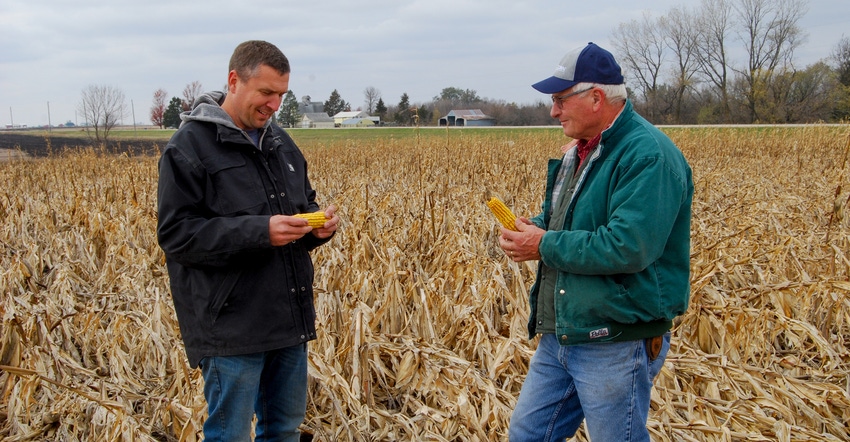October 30, 2020

Disking down a crop after you’ve put time and money into planting and growing it is a difficult decision. Many farmers were faced with that choice after the derecho windstorm tore across a wide area of Iowa on Aug. 10, bending and breaking cornstalks, and leaving stalks and ears lying on the ground. Drought also weakened stalks and severely hurt yields.
Related: Meet cash flow needs
Farming in Boone County in central Iowa, Rod Pierce and son Bret had to make that tough decision: Wait and try to harvest the flattened and tangled cornfields, or disk it down if the crop insurance adjuster deemed the field mechanically unharvestable. They did some of both.
Hurricane-force winds up to 130 mph hit their fields, as it did those of many other farmers. “The derecho struck through the heart of our acres,” Bret says. “We were very lucky none of us got hurt, as we were outdoors working and the storm developed so fast. My wife was driving our car in the storm, going to pick up our kids.”
Flattened fields, tangled stalks
Like many other farmers, they had flattened cornfields and tangled stalks. “We asked our crop insurance adjuster to check our most badly damaged fields first, those with broken stalks,” Bret says. “That was a week or so after the storm. The adjuster totaled those fields right away, and we disked them. We wanted to get as many ears and kernels that were on the ground to germinate as we could. The volunteer corn could then grow this fall and be winter-killed, to reduce the amount of volunteer corn we’ll have to control in our fields next spring.”
The insurance adjuster returned a month and a half later and zeroed out two more of Bret’s fields. Stalks that were halfway standing in late August had deteriorated and collapsed by October.
“You weigh the cost of waiting to harvest the flattened and tangled fields, and you have more expense,” Bret says. “Or do you go ahead and disk them down early? Either way, there are so many kernels in the soil you’ll still have volunteer corn to control next spring.”
While Bret has mostly a 50-50 corn-soybean rotation, his dad plants 95% continuous corn. In 2021, Rod will be planting a lot more soybeans, as there are herbicide options available to control volunteer corn in soybeans. “There aren’t any herbicide options to use to spray volunteer corn growing in your regular corn, without killing the regular corn,” Rod notes.
He foresees a significant increase in soybean acreage in 2021 in areas of the state where there was so much downed corn this year.
Quality of 2020 corn good
“I’m very happy with the quality of corn we harvested from these fields this fall,” says Rod, who serves on the Iowa Corn Promotion Board. “Early on, we were worried about the potential for mold and toxins developing. But it didn’t happen, as the dry weather helped us there. The fields that were the biggest worry were those where hail hit. Hail dinged the kernels on the ears of those plants and may have led to a little mold forming in some fields. But in our area, it’s been very minimal this fall.”
Test weights are surprisingly better than expected. “It’s down a little, but we’ve had such good test weights the past few years,” he says. “The standard is 56 pounds per bushel, and our corn has averaged 55 to 56 this year. That’s good-quality corn, although a little lighter than the 58- to 60-pound-per-bushel corn we harvested in 2018 and 2019.”
Corn quality overall in Iowa is good this fall. “I’ve asked grain buyers, and they agree,” Rod says. “When harvest began this fall with so much downed corn, they warned that aflatoxin could be an issue. But we’ve not had such problems, so far.”
Dry weather this fall helped to get downed stalks to flow into the corn head, but with damp weather later in October, the crop bunched up.
“A maneuver that helped us this fall was to harvest the east-west rows at a 30-degree angle,” Rod says. “We were able to harvest in both directions through the field by doing that. But it was still slow. This is a harvest we won’t forget.”
About the Author(s)
You May Also Like






